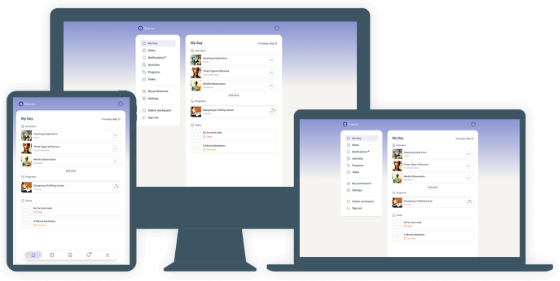In the fast-paced world of mental health care, efficient note-taking is crucial for therapists, coaches, and practitioners [1]. Therapy notes serve as a vital tool for recording client information, tracking progress, and ensuring continuity of care [2]. However, the process of documenting sessions can be time-consuming and challenging, often detracting from the therapeutic experience itself.
Enter therapy note abbreviations – a powerful solution to enhance efficiency and streamline the documentation process [3]. By utilizing a well-developed system of abbreviations, mental health professionals can save time, improve accuracy, and focus more on their clients’ needs. This blog post will explore the world of therapy note abbreviations, providing valuable insights on their importance, implementation, and best practices.
Whether you’re a seasoned therapist looking to refine your note-taking skills or a newcomer to the field seeking to establish efficient documentation habits, this guide will equip you with the knowledge and tools to master therapy note abbreviations. Let’s dive in and discover how this simple yet effective technique can revolutionize your practice and ultimately lead to better client care.
The Role of Therapy Notes in Mental Health Care
Therapy notes play a pivotal role in mental health care, serving as a comprehensive record of a client’s therapeutic journey [4]. These notes capture essential information about the client’s background, assessments, treatment plans, interventions, and progress over time. They are more than just a memory aid for therapists; they are a crucial component of professional practice with far-reaching implications.
Purpose and Significance:
- Continuity of Care: Therapy notes ensure that practitioners can easily review previous sessions, track progress, and make informed decisions about the direction of treatment.
- Legal and Ethical Compliance: Accurate documentation is a legal and ethical requirement in the mental health field. Notes serve as a record of services provided and can be crucial in legal situations or insurance claims.
- Collaborative Care: When multiple professionals are involved in a client’s care, therapy notes facilitate effective communication and coordination among team members.
- Treatment Planning: Detailed notes help in developing and refining treatment plans, allowing therapists to tailor interventions based on documented progress and challenges.
- Quality Assurance: Regular review of therapy notes can help practitioners assess the effectiveness of their interventions and identify areas for improvement in their practice.
Legal and Ethical Requirements:
Mental health professionals are bound by strict legal and ethical standards regarding documentation. These requirements may vary depending on location and specific professional guidelines, but generally include:
- Maintaining confidentiality and security of client information
- Documenting services provided, including date, duration, and type of therapy
- Recording relevant clinical observations, interventions, and client progress
- Ensuring notes are legible, accurate, and timely
- Retaining records for a specified period as mandated by local regulations
By understanding and appreciating the critical role of therapy notes, practitioners can approach the task of documentation with renewed purpose and commitment. This foundation sets the stage for exploring how abbreviations can enhance the note-taking process while maintaining the integrity and value of these essential records.
Common Challenges in Therapy Note-Taking
While therapy notes are indispensable, the process of creating them often presents several challenges for mental health professionals [5]. Recognizing these hurdles is the first step toward finding effective solutions, such as implementing a system of abbreviations. Let’s explore the three most common challenges faced in therapy note-taking:
1. Time Constraints:
One of the most pressing issues for therapists is the limited time available for documentation. With back-to-back sessions and a multitude of administrative tasks, finding adequate time to write comprehensive notes can be daunting. Many practitioners find themselves rushing through documentation between sessions or staying late to catch up, which can lead to burnout and decreased job satisfaction.
- Impact: Rushed notes may lack detail or clarity, potentially compromising the quality of care and creating issues for future reference.
- Consequence: Important information might be omitted or incorrectly recorded, affecting treatment planning and continuity of care.
2. Information Overload:
Therapy sessions often involve a wealth of information shared by clients, including complex emotions, life events, and subtle nuances in behavior or thought patterns. Capturing all this information accurately and concisely can be overwhelming.
- Challenge: Distinguishing between essential and non-essential information in real-time.
- Risk: Over-documenting can lead to verbose, hard-to-navigate notes, while under-documenting may result in missing crucial details.
3. Maintaining Clarity and Accuracy:
Striking a balance between efficiency and thoroughness is crucial in therapy note-taking. Notes must be clear enough for future reference by the therapist or other professionals involved in the client’s care, while also being accurate representations of the session.
- Difficulty: Ensuring that hastily written notes remain intelligible and precise.
- Potential Issue: Ambiguous or unclear notes can lead to misinterpretation, affecting the quality of ongoing treatment.
Addressing these challenges is essential for maintaining high-quality documentation in mental health practice. The implementation of a well-designed abbreviation system can significantly alleviate these issues by allowing therapists to record information more quickly and efficiently without sacrificing clarity or accuracy. In the following sections, we’ll explore how abbreviations can be effectively utilized to overcome these common hurdles in therapy note-taking.
Understanding Therapy Note Abbreviations
Therapy note abbreviations are shortened forms of words or phrases commonly used in mental health documentation [6]. These abbreviations serve as a powerful tool to enhance the efficiency and effectiveness of note-taking in therapeutic settings. By understanding the purpose and benefits of using abbreviations, practitioners can significantly improve their documentation process.
Definition and Purpose:
Therapy note abbreviations are concise representations of frequently used terms, diagnoses, treatments, or concepts in mental health care. Their primary purpose is to streamline the note-taking process, allowing therapists to record information quickly and accurately. These abbreviations can range from simple acronyms to more complex shorthand systems, depending on the practitioner’s preference and the specific needs of their practice.
Examples of common abbreviations include:
- Dx: Diagnosis
- Tx: Treatment
- Pt: Patient
- Hx: History
- Sx: Symptoms
Benefits of Using Abbreviations in Therapy Notes:
- Time-Saving: Abbreviations significantly reduce the time spent on writing, allowing therapists to focus more on the client and less on documentation.
- Increased Efficiency: By using shorthand, practitioners can record more information in less time, leading to more comprehensive notes without extending the documentation process.
- Improved Clarity: When used consistently, abbreviations can actually enhance the clarity of notes by providing a standardized format for common terms and concepts.
- Enhanced Focus: Less time spent on writing means more attention can be devoted to the client during sessions, potentially improving the quality of care.
- Reduced Physical Strain: For those who handwrite notes, abbreviations can reduce the physical effort required, potentially decreasing the risk of repetitive strain injuries.
- Consistency in Documentation: A well-established abbreviation system promotes uniformity in note-taking across sessions and even among different practitioners within the same practice.
- Easier Review: Concise notes with standardized abbreviations can be quicker to review and interpret, saving time during case reviews or when preparing for follow-up sessions.
| Benefit | Description |
|---|---|
| Time-saving | Reduces writing time, allowing more focus on the client |
| Increased efficiency | Enables recording more information in less time |
| Improved clarity | Standardizes format for common terms and concepts |
| Enhanced focus | Less writing means more attention to the client during sessions |
| Consistency | Promotes uniformity in documentation across sessions and practitioners |
By incorporating a thoughtful system of abbreviations into their note-taking process, mental health professionals can overcome many of the common challenges associated with documentation. However, it’s crucial to remember that the use of abbreviations should always enhance, rather than hinder, the clarity and accuracy of therapy notes. In the next section, we’ll explore some essential abbreviations that every practitioner should know to get started with this efficient documentation method.
Essential Therapy Note Abbreviations Every Practitioner Should Know
Adopting a set of commonly used abbreviations is a great starting point for enhancing your therapy note-taking efficiency [7]. While it’s important to develop a personalized system that works for your specific practice, familiarizing yourself with widely recognized abbreviations can provide a solid foundation. Here’s a list of essential therapy note abbreviations every practitioner should know, along with examples of how to use them in context:
1. General Abbreviations:
- Pt: Patient
- Tx: Treatment
- Dx: Diagnosis
- Hx: History
- Sx: Symptoms
- Rx: Prescription
Example: “Pt reports Sx of anxiety. Hx reveals childhood trauma. Dx: PTSD. Tx plan includes CBT and relaxation techniques. No Rx at this time.”
2. Mental Status Examination:
- A&O: Alert and Oriented
- SI: Suicidal Ideation
- HI: Homicidal Ideation
- AH: Auditory Hallucinations
- VH: Visual Hallucinations
- WNL: Within Normal Limits
Example: “Pt A&O x3 (person, place, time). No SI/HI reported. Mood depressed, affect congruent. Thought process WNL.”
3. Common Diagnoses:
- MDD: Major Depressive Disorder
- GAD: Generalized Anxiety Disorder
- OCD: Obsessive-Compulsive Disorder
- PTSD: Post-Traumatic Stress Disorder
- BPD: Borderline Personality Disorder
- ADHD: Attention-Deficit/Hyperactivity Disorder
Example: “Differential Dx includes MDD and GAD. Will monitor for symptoms of OCD in future sessions.”
4. Treatment Approaches:
- CBT: Cognitive Behavioral Therapy
- DBT: Dialectical Behavior Therapy
- IPT: Interpersonal Therapy
- EMDR: Eye Movement Desensitization and Reprocessing
- ACT: Acceptance and Commitment Therapy
Example: “Implemented CBT techniques for negative thought patterns. Pt receptive to ACT principles. Consider DBT skills training for emotion regulation.”
5. Session Content:
- HW: Homework
- G: Goal
- I: Intervention
- R: Response
- P: Plan
Example: “G: Reduce anxiety symptoms. I: Progressive muscle relaxation. R: Pt reports decreased tension. P: Continue practice daily. HW: Anxiety log.”
Using these abbreviations in your therapy notes can significantly streamline your documentation process while maintaining clarity and accuracy. Remember to use abbreviations consistently and provide a key or legend if sharing notes with other professionals. As you become more comfortable with these essential abbreviations, you can expand your repertoire to include more specific terms relevant to your particular area of practice.
| Abbreviation | Meaning | Usage Example |
|---|---|---|
| Pt | Patient | Pt reports improved mood |
| Tx | Treatment | Tx plan includes CBT |
| Dx | Diagnosis | Dx: Major Depressive Disorder |
| SI | Suicidal Ideation | No SI reported today |
| GAD | Generalized Anxiety Disorder | Symptoms consistent with GAD |
Developing Your Personal Abbreviation System
Creating a personalized abbreviation system can significantly enhance your note-taking efficiency while ensuring that your documentation remains clear and meaningful to you [7]. Here are key considerations and strategies for developing an effective abbreviation system:
1. Consistency is Key:
Establish a consistent set of rules for creating abbreviations. For example, you might decide to use the first letter of each word in a phrase, or the first two letters of longer words. Whatever system you choose, apply it consistently across all your abbreviations.
Example: “Cognitive Behavioral Therapy” could be abbreviated as “CBT” or “CoBeTh” depending on your chosen system.
2. Consider Context:
Ensure that your abbreviations make sense within the context of your notes. An abbreviation that works well in one context might be confusing in another.
Example: “PT” could mean “patient” or “physical therapy” – choose the meaning that’s most relevant to your practice and stick with it.
3. Balance Between Personalized and Standard Abbreviations:
While creating personalized abbreviations can be helpful, it’s also important to incorporate widely recognized abbreviations in your field. This ensures that your notes remain comprehensible to other professionals if needed.
Personalized example: “RLXN” for “relaxation techniques”
Standard example: “GAD” for “Generalized Anxiety Disorder”
4. Create a Reference Guide:
Develop a comprehensive list of your abbreviations and their meanings. This guide can serve as a quick reference for you and can be shared with colleagues or supervisees who might need to interpret your notes.
5. Regular Review and Refinement:
Periodically review your abbreviation system. As your practice evolves, you may need to add new abbreviations or modify existing ones. Regular refinement ensures your system remains relevant and efficient.
6. Consider Readability:
While abbreviations save time, they shouldn’t compromise the readability of your notes. Aim for a balance between brevity and clarity.
Example: Instead of “Pt rprt incr anx,” write “Pt reports incr anx” for better readability.
7. Use Caution with Sensitive Information:
Be mindful when abbreviating sensitive or potentially controversial information. In some cases, it may be better to write things out in full to avoid any potential misinterpretation.
By thoughtfully developing your personal abbreviation system, you can create a powerful tool that enhances your note-taking efficiency while maintaining the clarity and professionalism of your documentation. Remember, the goal is to create a system that works for you and supports your clinical practice.
Expanding Your Abbreviation Toolkit
As you become more comfortable with using abbreviations in your therapy notes, you may want to expand your toolkit to cover a wider range of terms and concepts [6]. This expansion can further enhance your efficiency and allow for more comprehensive documentation. Here are some strategies and resources to help you grow your abbreviation repertoire:
1. Professional Development Workshops:
Attend workshops or seminars focused on documentation in mental health. These often include sections on efficient note-taking and commonly used abbreviations in the field.
2. Online Courses:
Enroll in online courses specifically designed for mental health professionals to improve their documentation skills. Many of these courses cover advanced abbreviation techniques.
3. Professional Association Resources:
Check resources provided by professional associations in your field. They often have guides or webinars on best practices in documentation, including the use of abbreviations.
4. Peer Learning:
Collaborate with colleagues to share and learn new abbreviations. You might discover useful shortcuts that others have developed in their practice.
5. Specialty-Specific Abbreviations:
If you specialize in a particular area of mental health, research abbreviations commonly used in that niche. For example, trauma-focused therapists might use specific abbreviations related to PTSD symptoms.
6. Technology Integration:
Explore software or apps designed for mental health professionals that include customizable abbreviation features. These tools can help you manage and expand your abbreviation system efficiently.
7. Continuous Learning:
Stay updated with new developments in your field. As new therapeutic approaches or diagnostic criteria emerge, new abbreviations may become relevant.
8. Create Category-Specific Lists:
Develop lists of abbreviations for different categories such as diagnoses, interventions, assessment tools, and common phrases. This organized approach can help you quickly find and implement relevant abbreviations.
9. Practice and Refinement:
Regularly practice using new abbreviations in your notes. Review and refine your usage to ensure they’re enhancing rather than hindering your documentation process.
10. Feedback Loop:
If you work in a team, establish a feedback loop where colleagues can share insights on the clarity and effectiveness of each other’s abbreviation usage.
Remember, expanding your abbreviation toolkit is an ongoing process. The goal is to continuously improve your efficiency while maintaining the clarity and professionalism of your therapy notes. As you grow your repertoire, always prioritize the readability and accuracy of your documentation to ensure it serves its primary purpose of supporting quality patient care.
Conclusion
Mastering the art of therapy note abbreviations is a valuable skill that can significantly enhance the efficiency and effectiveness of mental health professionals [5]. By implementing a well-thought-out abbreviation system, therapists can overcome common challenges in note-taking, such as time constraints and information overload, while maintaining the clarity and accuracy essential for quality care.
Throughout this blog post, we’ve explored the crucial role of therapy notes in mental health care, the common challenges faced in documentation, and the numerous benefits of using abbreviations. We’ve provided a foundational set of abbreviations every practitioner should know, guidance on developing a personalized abbreviation system, and best practices for implementation.
Key takeaways include:
- Abbreviations can save time and increase efficiency in note-taking.
- A balance between personalized and standard abbreviations is crucial.
- Consistency and clarity should always be prioritized when using abbreviations.
- Regular review and refinement of your abbreviation system is essential.
- Expanding your abbreviation toolkit is an ongoing process that can continually improve your practice.
Remember, the ultimate goal of using abbreviations in therapy notes is to streamline the documentation process, allowing you to focus more on your clients and less on paperwork. However, it’s crucial to ensure that your use of abbreviations never compromises the quality or comprehensibility of your notes.
As you move forward in implementing or refining your abbreviation system, stay open to learning and adapting. The field of mental health is ever-evolving, and your documentation practices should evolve with it. By mastering therapy note abbreviations, you’re not just saving time – you’re enhancing your ability to provide high-quality, well-documented care to your clients.
Embrace this powerful tool, but always keep in mind the primary purpose of your notes: to support effective treatment, ensure continuity of care, and maintain professional and legal standards. With practice and persistence, you’ll find that mastering therapy note abbreviations becomes an invaluable asset in your professional toolkit.
| Abbreviation | Meaning | Usage Example |
|---|---|---|
| Pt | Patient | Pt reports improved mood |
| Tx | Treatment | Tx plan includes CBT |
| Dx | Diagnosis | Dx: Major Depressive Disorder |
| SI | Suicidal Ideation | No SI reported today |
| GAD | Generalized Anxiety Disorder | Symptoms consistent with GAD |
Frequently Asked Questions
To ensure compliance, familiarize yourself with your local regulations and professional guidelines. Consult your licensing board or professional association for specific requirements. Generally, it’s advisable to use widely recognized abbreviations, provide a key or legend with your notes, and avoid abbreviating sensitive information. Always prioritize clarity and accuracy over brevity. When in doubt, write out the full term to prevent any potential misunderstandings or legal issues.
Start by conducting a workshop to introduce the concept and benefits of using abbreviations. Collaboratively develop a standardized list of abbreviations that all team members agree upon. Create a reference guide and make it easily accessible. Implement the system gradually, starting with a core set of abbreviations and expanding over time. Establish a regular review process to address any challenges and incorporate new abbreviations as needed. Encourage open communication and feedback to ensure the system works for everyone.
For telehealth sessions, consider using a text expansion tool that automatically converts your abbreviations into full text. This can help maintain clarity in your notes while still saving time. Organize your abbreviations into categories for easy access during the session. Use a split-screen setup with your video call on one side and your notes on the other. Practice touch typing to maintain eye contact with your client while using abbreviations. Remember to review and edit your notes after the session to ensure accuracy and completeness.
Potential drawbacks include misinterpretation by other professionals, difficulty in reading notes over time, and potential legal issues if abbreviations are unclear. To mitigate these risks, use only widely recognized abbreviations or provide a clear legend. Regularly review and update your abbreviation system. Be cautious with abbreviating diagnoses or sensitive information. Always prioritize clarity over brevity. Consider having a colleague review your notes periodically to ensure they remain comprehensible to others.
Strike a balance by using abbreviations for common terms, diagnoses, and standard interventions, while writing out more detailed narratives for specific client experiences or complex interactions. Use abbreviations as a framework to structure your notes, but expand on key points with full sentences. Consider using a hybrid approach where you use abbreviations during the session for quick note-taking, then elaborate on these points in a more narrative style after the session. Always ensure that your notes, whether abbreviated or not, capture the essence of the therapeutic process and client progress.
References
- ^ Gutheil, T. G., & Brodsky, A. (2008). Preventing boundary violations in clinical practice. Guilford Press.
- ^ Bender, S., & Messner, E. (2003). Becoming a therapist: What do I say, and why?. Guilford Press.
- ^ Poznanski, J. J., & McLennan, J. (2003). Becoming a psychologist: Is there a right way?. Australian Psychologist, 38(2), 79-85. https://doi.org/10.1080/00050060310001707137
- ^ Cameron, S., & Turtle‐Song, I. (2002). Learning to write case notes using the SOAP format. Journal of Counseling & Development, 80(3), 286-292. https://doi.org/10.1002/j.1556-6678.2002.tb00193.x
- ^ Pieper, M. H. (2003). Constructing and deconstructing clinical documentation. Smith College Studies in Social Work, 73(3), 313-325. https://doi.org/10.1080/00377310309517689
- ^ Prieto, L. R., & Scheel, K. R. (2002). Using case documentation to strengthen counselor trainees' case conceptualization skills. Journal of Counseling & Development, 80(1), 11-21. https://doi.org/10.1002/j.1556-6678.2002.tb00161.x
- ^ Gehart, D. R. (2016). Theory and treatment planning in counseling and psychotherapy. Cengage Learning.



